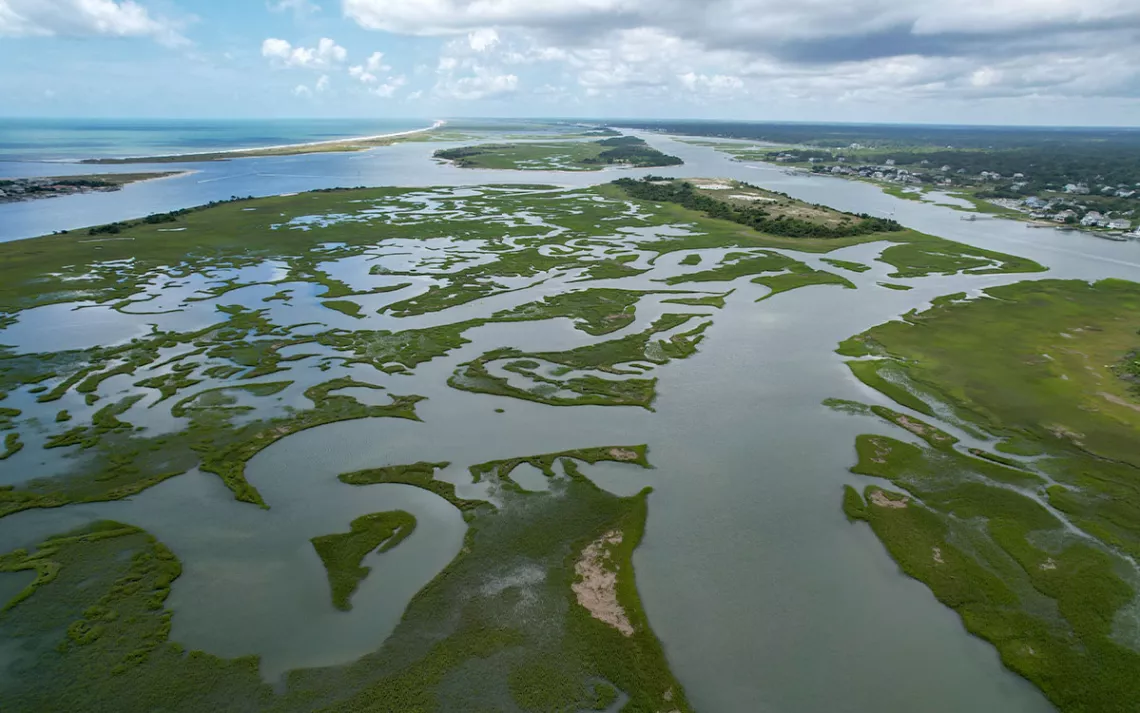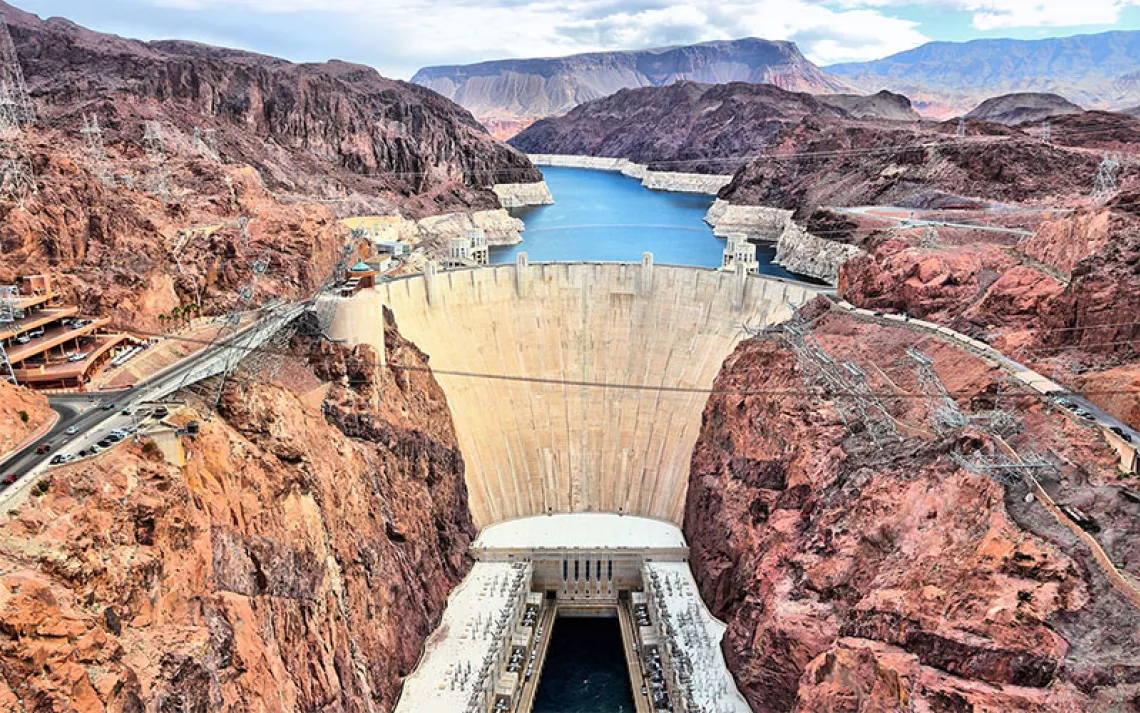Could North Carolina’s “Fairy Circles” Herald the Next Clean-Energy Boom?
Elevated hydrogen levels could point to a rich renewable energy source

Photo by David Garrison/iStock
Many people are drawn to Eastern North Carolina by the aroma of its legendary vinegar-based barbeque. Geoffrey Ellis admits that pulled pork was a big perk of his February trip to the region. But officially, the research geologist with the U.S. Geological Survey had traveled south of Fayetteville in pursuit of a target with no smell at all: hydrogen gas.
While hydrogen is the most common element in the universe, it’s also 14 times lighter than air and easily escapes into space. That makes it extremely rare in Earth’s atmosphere, present at an average of just .5 parts per million. Nearly all of the hydrogen used for fuel and industrial processes is made artificially, either by reacting methane gas with steam or breaking down water through electrolysis.
Yet Ellis knew that in 2012, an international research team led by the geochemist Viacheslav Zgonnik had visited North Carolina and found much higher levels of hydrogen, hundreds or thousands of parts per million, around the unusual geological features known locally as Carolina bays. These shallow, oval, often swampy depressions, the largest up to five miles across, have long intrigued geologists and the general public alike. In the U.S., they stretch in a sporadic band along the East Coast from the Florida-Georgia border up to New Jersey. Similar features are present all over the world, including Russia, Brazil, and Australia.
Scientists aren’t entirely sure how the bays form, Ellis says. Hypotheses include the warming of permafrost after the last Ice Age, the action of strong winds over many centuries, and the melting of icy fragments from exploded comets. Popular names for the features, like “fairy circles” and “witch rings,” often ascribe more supernatural origins. The elevated hydrogen readings added to the mystery, and Ellis wanted to see if North Carolina’s bays still harbored the gas a decade after Zgonnik’s measurements.
The concentrations Ellis detected were the same or even higher than before—the first evidence of long-term, naturally occurring hydrogen seepage in the United States. “The trends were very consistent,” Ellis says. “I was surprised; I expected that we would see more variability over time. To be honest, I don’t really know what that means.”
Zgonnik is less cautious in his interpretation. He sees the bays as markers of potentially massive resources trapped below the surface, just waiting to transform the world’s energy economy.
“We’re dealing with a long-lasting flow of hydrogen,” Zgonnik asserts. “If it is long lasting, it means that we can, by installing the right system, capture this flow, harvest this hydrogen, and open the pathway for a new source of energy.”
Even a decade ago, the idea that Earth held commercially meaningful quantities of hydrogen was considered scientifically dubious at best. Those who touted hydrogen as a clean fuel—it produces only water when burned—regarded it as a secondary energy source that would have to be produced using renewable or nuclear power to avoid carbon emissions.
But proof of concept for harvesting the gas has existed since 2012, when a village in Mali began tapping a hydrogen wellto power its electricity generation. Subsequent findings in North Carolina and elsewhere have stirred a new wave of excitement about what’s now called geologic, “white,” or “gold” hydrogen. The Denver-based company Koloma recently raised $245 million in venture capital to search for geologic hydrogen, while the U.S. Department of Energy awarded $20 million in grants toward research on the topic in February.
The technology used to extract hydrogen looks similar to that used for fossil fuels like methane gas and oil, says Zgonnik, whose company Natural Hydrogen Energy LLC drilled America’s first exploratory well in Nebraska. Unlike the limited deposits of those resources, however, he believes that geologic hydrogen represents a continuous flow. “Solar energy is the flux of photons from the sun. Wind energy is the flux of the air,” he says. “In our case, we are dealing with the flux of hydrogen from the depths, which I believe will be a significant contributor to the renewable energy mix.”
Several ongoing geological processes can generate hydrogen, Zgonnik explains, such as radiolysis (the splitting of water by radioactive rocks) and the release of gas from the planet’s core. So too can serpentinization, the reaction of water with iron-rich rocks under the high temperatures of the Earth’s mantle.
Ellis emphasizes that the science remains uncertain, but he says serpentinization may be a good candidate for the hydrogen seen around the Carolina bays. He points to the East Coast Magnetic Anomaly, an iron-rich vein of rock buried several miles off the coast, and suggests that the hydrogen produced there may travel through porous sediments toward the coast until it finds a path to the surface.
The geology is plausible, says Kathleen Farrell, a senior geologist at the North Carolina Geological Survey who hosted Zgonnik’s 2012 visit and collaborated on the research. “I'm a firm believer that the Carolina bays are conduits for water and gas escape from deeper deposits,” she says, comparing them to the sinkholes that form in the same area.
Farrell and NCGS section xhief Dwain Veach say it’s still premature to discuss the economic possibilities tied to the Carolina bays. The state scientists hope to continue partnering with federal and private researchers to learn more about where the hydrogen is coming from and whether it’s commercially viable. Ellis suspects that the real prize, if it exists, might lie offshore instead of directly under the bays, which would raise all sorts of logistical and environmental questions.
“We are actually at the very beginning of the journey,” acknowledges Zgonnik. “But the last time we unveiled a new source of energy, it was nuclear a century ago. This is a very rare situation in history, and it’s extremely exciting.”
 The Magazine of The Sierra Club
The Magazine of The Sierra Club



